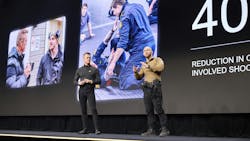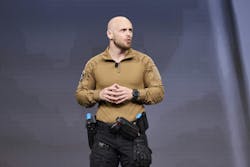Police Trainer Wants TASERs at Forefront of Officers' Options
What to know
- Espen Dahlen-Lervåg, a Norwegian police officer and law enforcement trainer, promotes high-stress, reality-based TASER 10 training that builds officer trust and confidence in the device.
- He emphasizes shifting from a firearm-centric culture to a simplified, effective combatives training that allows officers to "do more with less," regardless of physical skill level or experience.
- Advocates also are for forward-hip TASER placement at a 45-degree angle in order to improve weapon retention, accessibility and operational efficiency in dynamic, close-contact situations.
More on OFFICER.com
Download the May/June issue of OFFICER Magazine.
Click Here to subscribe to OFFICER Magazine.
Use of force and less-lethal training is constantly evolving with the focus on saving more lives. In 2022, Axon announced its ‘Moonshot’ goal to reduce U.S. gun-related deaths between police and the public by 50% in 10 years. During the opening session of Axon Week 2025 at the Phoenix Convention Center in April, Axon Founder and CEO Rick Smith introduced Norwegian police officer, trainer and researcher Espen Dahlen-Lervåg, who focuses on combatives and close-quarters TASER training and is looking to further advance the company’s goal.
“He’s one of the most forward-thinking trainers I’ve ever met,” Smith told the audience. “He’s not just focused on how we can use the TASER 10, he’s focused on something deeper. How do we build true trust in the user? Because, let’s be honest, the hardware can be perfect, but if these officers don’t feel it working under pressure in a real fight, they’re not going to rely on them when things matter most. Espen Dahlen-Lervåg is changing that through hands-on, high-stress, reality-based training.”
A new approach to TASER training
Dahlen-Lervåg spoke to those in attendance about the TASER 10 and how he believes it outperforms the firearm in many situations. “It’s actually so good that we can already talk about it outperforming the gun in many settings and scenarios, especially within combatives,” he told the crowd. “And the hardware is only going to continue to improve. It can become as good as we want it to be, but if we don’t do something with the culture that focuses in and around firearms as the primary weapon, I’m afraid that we won’t reach that ‘Moonshot’ goal. The way to do that, I believe, is going to be through honest and realistic combatives training.”
According to Espen, if officers can be placed in situations where they feel like they are fighting for their lives, and they are trusting their TASER energy weapon, they will then be able to trust it out on the street. “We can actually empirically prove that this new approach outperforms traditional training in regard to having people go for the TASER more often and have a higher confidence level within their skill set,” he said, adding that some people may view his approach as controversial. “That’s what I believed in the beginning as well, but when I put myself through this training, I saw that I was performing better with the TASER 10 than I did with just my hands-on skills or when focusing more on the firearm.”
He stressed that trainers can’t just teach or show officers these techniques, and that the officers have to experience them for themselves. “If they do that, I think that’s going to be the single most impactful thing that we can do in order to save lives and create that trust. I think that’s going to be one of the missing pieces in regard to reaching the Moonshot goal.”
He went into some of the arguments made for preferring a TASER energy weapon versus a firearm in a close quarters situation. “As you see, I’ve mounted my TASER 10 forward of my hips at a 45 degree. There are several reasons for doing that,” he said. “Having it on the front of my hips gives me the opportunity to get away with learning fewer techniques for weapon retention. It’s going to be more difficult to grab from different angles and some of the messages we want get across with our training is that we can actually mount a larger degree of offense while we’re standing, using the TASER 10 more actively, or mount a larger degree of defense while we’re on the ground fighting in and around it.”
Following Dahlen-Lervåg’s demonstration, Smith recalled traveling to Norway to observe his training. “He stood in front of a group of people and said, ‘I’m going to show you that the TASER 10 is a better close quarters weapon than a gun.’ That’s crazy talk, even though that’s our goal long term. By the end of the two-day course, the 93 trainers from the Nordics were basically agreeing with that statement.”
Doing more with less
Dahlen-Lervåg spoke with OFFICER Magazine following the session about his work and how he believes all officers can do more with less when it comes to use-of-force and weapons retention. He currently serves as a training coordinator and national lead on conducted electrical weapons (CEWs) in Norway. He also oversees combatives and use-of-force education for the country at the Norwegian Police University College (PolitiHøgskolen). He also has a black belt in Brazilian Jiu-Jitsu and has competed in MMA in Europe. His work on his associate professorship within combatives focuses on simplicity and doing more with less in a constantly evolving tactical sphere, where he says a lot of officers tend to do more than they should in regard to the time they have available for training.
A representative from Axon first found out about the training program DahlenLervåg was working on. “What he did with our training was pretty unique, focusing on the TASER 10 around combative elements—at least we hadn’t seen it before. We saw that we performed better using combatives in close quarter situations than using just their hands on-skills and focusing predominantly on the firearm,” he says. “I thought it was something that we needed to get out there.”
Earlier this year, his team invited the neighboring Scandinavian countries to come to Norway including Denmark, Sweden, Iceland, Finland and the Netherlands. Axon Founder and CEO Rick Smith and Pat Madden, Senior VP and Head of TASER at Axon attended the training event. “They really loved it and invited me over here,” he says.
A lot of his training is based on simplifying the movements an officer makes. “Do we really need that many outputs. I know that it significantly impacts the performance rate. It’s the same with technical movements as well. Officers can have a few and administer those principles.”
One difference in Dahlen-Lervåg’s training is the actual location of the TASER energy weapon on the officer. He prefers a cross draw, versus keeping the device holstered on his weak side, which is traditionally taught. He says that he wasn’t aware of the weak side draw until he visited the U.S. “One of the arguments I’ve heard is so that you don’t mix them up. The terminology for that is ‘bilateral symmetry.’ If you are really stressed, you might lock up. Gross motor skills take over. This happens with both hands, you should only operate one tool. It does not matter if you draw with your left or right hand.”
He says that he keeps his TASER energy weapon holstered at a 45-degree angle forward of his hips. “Having the ability from a de-escalation perspective, you are ready for something. Also, having in the front, it can allow me to do more with less in regard to retention techniques.” A lot of the movements he works with his officers on deal with positions where the officer is in a compromised position in close quarters, standing or on the ground.
According to Dahlen-Lervåg, law enforcement officers don’t need to be skilled in Brazilian Jiu-Jitsu or trained MMA fighters to take advantage of his techniques. “Back to simplicity, we focus in and around some basic movements to do within combatives,” he says. “Again, we’re trying to do as much as we can with as little as possible. Even though your competence level is lower, or you don’t have the same physical capacity, you still have to stick to the best practices of training. Why would you do something that is less efficient?”
About the Author
Paul Peluso
Editor
Paul Peluso is the Managing Editor of OFFICER Magazine and has been with the Officer Media Group since 2006. He began as an Associate Editor, writing and editing content for Officer.com. Previously, Paul worked as a reporter for several newspapers in the suburbs of Baltimore, MD.



